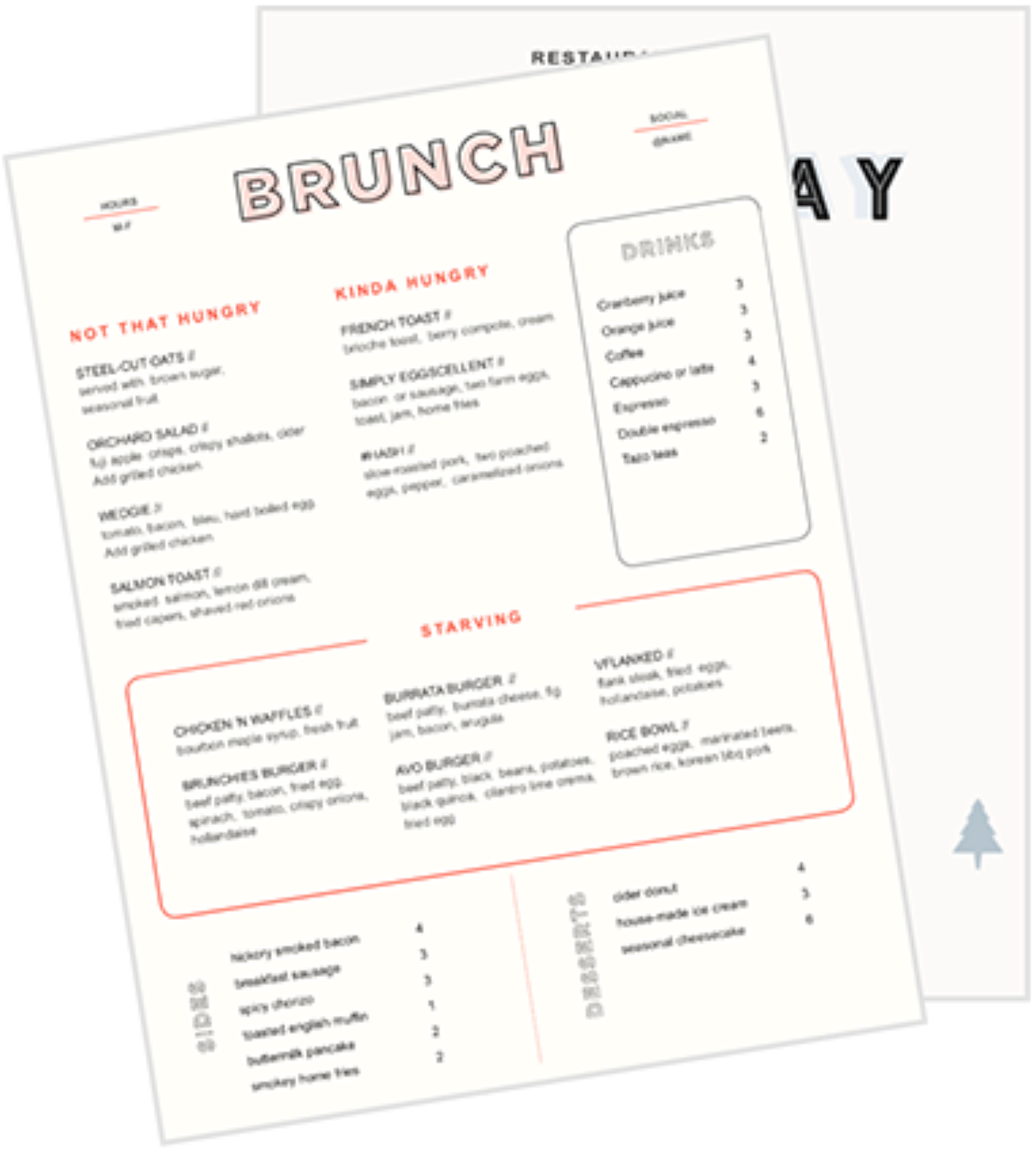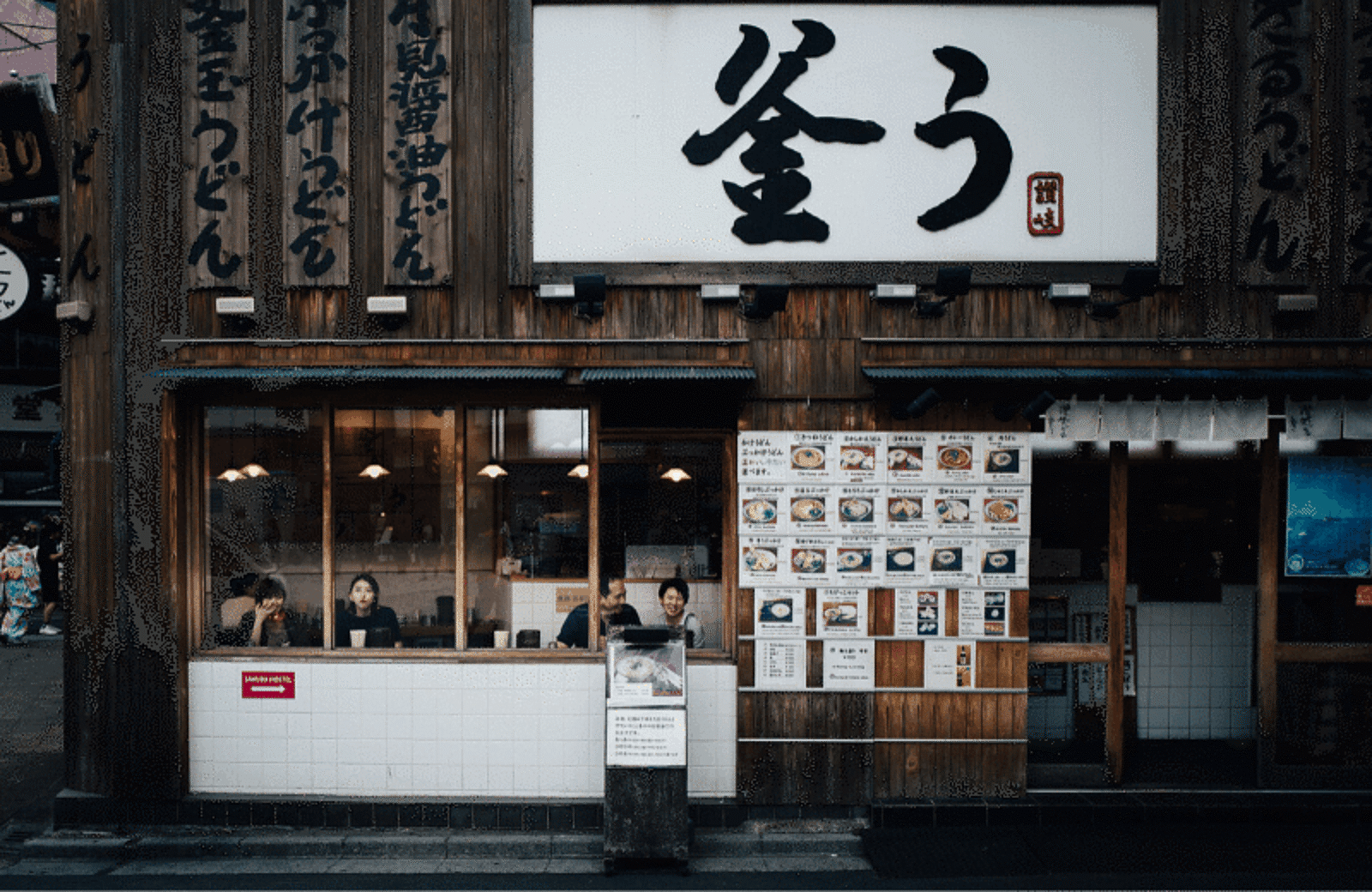
Menu Board Idea Examples: How to Use a Menu Board as a Revenue Tool
Here are some innovative menu board ideas and design ideas that can transform your establishment's interior design and profitability.

Caroline PriceAuthor


Restaurant Menu Templates
Use these menu templates as a starting point for your menu design or to give your menus a refresh.
Get free downloadAs a business owner in the food industry, whether you run a cozy coffee shop, a bustling fast food joint, or a trendy food truck, you know that your menu board is more than just a list of menu items – it's a powerful tool that can significantly impact your customer experience and boost sales. In today's competitive dining landscape, an eye-catching and effective restaurant menu board can set you apart from the competition, enhance your ambiance, and increase your average order value. Let's explore some innovative menu board ideas and design ideas that can transform your establishment's interior design and profitability.
Restaurant Menu Templates
Use these menu templates as a starting point for your menu design or to give your menus a refresh.

The Power of a Well-Designed Menu Display
“The menu is the most important internal marketing and sales tool a restaurant has. It is the only piece of printed advertising that you are virtually 100% sure will be read by the guest. Once placed in the guest's hand, it can directly influence not only what they will order, but ultimately how much they will spend,” writes Dave Pavesic, Ph.D., FMP for Restaurant Resource Group about the psychology of menu design.
Before diving into specific menu board ideas, it's crucial to understand why your menu display matters.
First impressions: Your menu board sign is often one of the first things customers see, setting the tone for their dining experience.
Decision-making influence: A well-designed menu board can guide customers towards high-margin food items and increase overall sales.
Brand reinforcement: Your menu board design should reflect your restaurant's personality and reinforce your brand identity.
Operational efficiency: Clear, easy-to-read signage can speed up the ordering process, reducing wait times and improving customer satisfaction.
Menu Board Ideas to Inspire Your Restaurant
Now, let's explore some innovative menu board ideas to elevate your restaurant's presentation and performance.
Digital Menu Boards and Digital Signage Software
Digital menu boards have revolutionized the way restaurants display their offerings. Check out some eye-catching digital design ideas here.
There are multiple reasons you should consider going digital:
- Easy updates: Change prices, add daily specials, or remove sold-out menu items in real-time without printing costs.
- Dynamic content: Showcase high-quality, mouth-watering food images, videos, or animations to entice customers.
- Dayparting: Automatically switch menus for breakfast, lunch, and dinner services.
- Integration with POS: Some digital menu systems can integrate with your point-of-sale system for seamless inventory management.
- Energy efficiency: LED screens consume less power than traditional illuminated boards.
- Implementation tip: Start with one digital display in a high-traffic area to test its impact before investing in a full system of digital displays.
Customizable Chalkboard Menus
Besides introducing a more rustic or artisanal feel, customizable chalkboards have lots of Instagram potential. Here are a few more reasons you should consider using chalkboard menu boards.
- Flexibility: Easily update menu items or prices with chalk.
- Artistic expression: Hire a local artist to create beautiful, eye-catching designs.
- Authenticity: Convey a sense of daily freshness and menu variety.
- Cost-effectiveness: Relatively inexpensive to implement and maintain.
- Design tip: Use high-quality chalkboard paint and invest in good lighting to ensure your chalkboard menu is always readable. Experiment with different fonts to create a unique look.
Mix-and-Match Modular Boards
Not only can you create a dynamic menu display with interchangeable panels, here are other reasons to use modular boards:
- Versatility: Easily swap out individual menu sections as needed.
- Visual interest: Use different color schemes for each section to create a visually appealing display.
- Scalability: Add or remove panels as your menu evolves.
- Organization tip: Group food items logically (e.g., appetizers, mains, desserts) and use consistent formatting across panels for a cohesive look.
Interactive Touch Screen Menus
Here’s how you can take customer engagement to the next level with interactive touch screen menus:
- Detailed information: Allow customers to explore dish ingredients, nutritional information, and allergen details.
- Customization: Enable customers to visualize customizations before ordering.
- Upselling opportunities: Suggest complementary items or upgrades based on selections.
- Multi-language support: Cater to a diverse customer base with multiple language options.
- Implementation consideration: Ensure your staff is trained to assist customers who may be less comfortable with technology.
Letter Boards and Wall Menus
The sky's the limit when it comes to the kind of designs you can create. Here are upsides of using letter boards or stylish wall menus:
- Retro charm: Appeal to customers' sense of nostalgia with a classic look.
- Customization: Easily change messages or highlight limited-time offers and best sellers.
- Visibility: Ensure your menu is readable even in low-light conditions.
- Design tip: Use a mix of white and colored letters to draw attention to specific menu items or promotions. Consider a hanging menu board for a unique touch.
Coffee Shop Menu Board Ideas
A coffee shop menu board is an essential communication tool. Try these enticing design ideas:
- Minimalist look: Use clean fonts and simple graphics for a modern, uncluttered look.
- Infographic-style: Visually represent different coffee drinks and their components.
- Seasonal special showcase: Highlight seasonal beverages and limited-time offers.
- Loyalty program display: Incorporate information about your loyalty program to encourage repeat visits.
- Inspiration tip: Look at how successful chains like Starbucks design their menu boards for ideas you can adapt to your unique brand.
Ice Cream Menu Board Ideas
Ice cream is all about whimsy and fun, and the signage should be too. Ice cream shops can benefit from these creative display ideas using menu boards:
- Colorful illustrations: Use vibrant graphics to represent different flavors.
- Flavor of the week spotlight: Dedicate a section of your menu board to highlight rotating specials.
- Toppings bar display: Visually showcase available toppings to encourage customization.
- Combo deal promotions: Use eye-catching designs to promote sundae combinations or family-size options.
Fast Food and Drive-Thru Menu Boards
Optimize the ordering process and more with fast food menu board ideas:
- Simplified layouts: Use clear, large fonts and minimal text to ensure readability from vehicles.
- Pre-sell boards: Place a smaller menu board earlier in the drive-thru lane to give customers more time to decide.
- Digital menu boards: Implement weather-resistant digital displays for easy updates and day-parting.
- Combo meal focus: Highlight value meals and combo options to increase average order value.
Food Truck Menu Boards
Food trucks can maximize their limited space with these menu board ideas:
- Magnetic menu boards: Use magnetic letters or panels for easy updates on the go.
- Foldable menu displays: Design a menu board that can be easily stored during transit.
- Window decal menus: Utilize window space for permanent menu items, with a separate board for daily specials.
- QR code menus: Include a QR code that customers can scan for a full digital menu on their phones.
DIY Menu Board Ideas
Feeling creative (and thrifty)? For budget-conscious business owners, consider these DIY menu board options:
- Repurposed wooden pallets: Create a rustic wall menu using reclaimed wood.
- Clipboard menus: Use clipboards to display printed menu cards that can be easily swapped out.
- Framed chalkboards: Combine the flexibility of a chalkboard with the polish of a framed display.
- Mason jar price displays: For cafes or ice cream shops, use labeled mason jars to display prices for different sizes.
Implementing Your New Menu Board: Best Practices
From text size to colors, there’s a lot of strategy that goes into creating an effective menu board. As you consider these innovative menu board ideas, keep the following best practices in mind:
- Prioritize readability: No matter how creative your design, ensure that menu items and prices are easy to read from a distance.
- Maintain brand consistency: Your menu board should align with your overall brand aesthetic and messaging.
- Highlight profit drivers: Use design elements to draw attention to high-margin items or daily specials.
- Consider your audience: Choose a menu board style that resonates with your target demographic.
- Test and iterate: Implement changes gradually and gather customer feedback to refine your approach.
- Train your staff: Ensure your team understands how to operate and maintain any new menu board systems.
- Plan for maintenance: Factor in ongoing costs and effort required to keep your menu board looking its best.
- Comply with regulations: Be aware of any local regulations regarding menu displays, particularly regarding nutritional information.
Menu Board FAQ’s for Restaurant Owners
How often should I update my menu board design?
Consider refreshing your design seasonally or whenever you make significant menu changes.
Can I create a professional menu board design without hiring a graphic designer?
Yes, tools like Canva offer menu board templates that can help you create professional-looking designs.
How do I choose between a digital menu board and a traditional one?
Consider factors like your budget, the frequency of menu changes, and your restaurant's overall aesthetic.
How can I make my specials stand out on the menu board?
Use contrasting colors, larger fonts, or dedicated sections to draw attention to your special offers.
Should I include prices on my menu board?
Generally, yes. Customers appreciate transparency, but consider de-emphasizing dollar signs to potentially increase spending.
How can I make my menu board more accessible for customers with visual impairments?
Use high-contrast color combinations, large, clear fonts, and consider offering braille or large-print menus as alternatives. For digital menu boards, ensure they're compatible with screen readers.
What are some cost-effective ways to update my menu board regularly?
Use changeable elements like chalkboards or letter boards for specials, implement a partially digital solution, or use modular designs that allow for easy swapping of individual sections.
How do I balance aesthetics with information density on my menu board?
Focus on essential information, use a clear hierarchy, and incorporate white space. Consider using icons or symbols to convey information concisely. If needed, provide more detailed information in separate menu cards or digital formats.
Are there any legal requirements I need to consider when designing my menu board?
Depending on your location, you may need to include calorie counts, allergen information, or other nutritional details. Check local regulations and consult with a legal professional to ensure compliance.
How can I use my menu board to promote my restaurant on social media?
Design your menu board to be visually appealing and "Instagrammable." Include your social media handles on the board, and consider creating special menu items or designs that encourage customers to share photos online.
Elevate Your Business with Innovative Menu Boards
Your menu board is a critical touchpoint in your customers' dining experience. By implementing innovative, eye-catching, and functional menu board ideas, you can enhance your establishment's atmosphere, streamline operations, and ultimately drive sales. Whether you opt for high-tech digital displays or artisanal chalkboard creations, the key is to choose a solution that aligns with your brand, engages your customers, and effectively showcases your culinary offerings.
“Menu design also directly influences sales revenue,” reinforces Pavesic. “Management is constantly forecasting business volume to estimate how much to buy, keep in inventory, and prepare. A properly designed menu makes these kinds of decisions easier and more accurate.”
Remember, the most successful menu boards are those that balance creativity with clarity, ensuring that your delicious dishes remain the true stars of the show. By thoughtfully designing and implementing your menu board, you're not just listing items – you're creating an experience that begins before the first bite and leaves a lasting impression on your customers.
As you embark on this menu board makeover journey, don't be afraid to experiment and gather feedback. Your perfect menu board solution might combine elements from several of these ideas or inspire you to create something entirely unique. The goal is to find a menu board that not only informs but also excites and delights your customers, setting the stage for an exceptional dining experience that keeps them coming back for more.
Is this article helpful?
DISCLAIMER: This information is provided for general informational purposes only, and publication does not constitute an endorsement. Toast does not warrant the accuracy or completeness of any information, text, graphics, links, or other items contained within this content. Toast does not guarantee you will achieve any specific results if you follow any advice herein. It may be advisable for you to consult with a professional such as a lawyer, accountant, or business advisor for advice specific to your situation.
Read More
Subscribe to On the Line
Sign up to get industry intel, advice, tools, and honest takes from real people tackling their restaurants’ greatest challenges.



